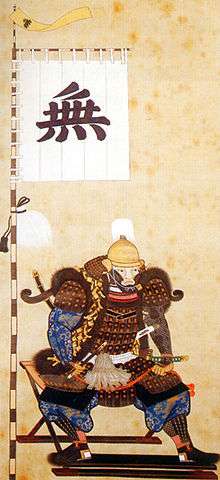Sengoku Hidehisa
| Sengoku Hidehisa | |
|---|---|
 Portrait of Sengoku Hidehisa | |
| Komoro han | |
|
In office 1585–1591 | |
| Monarch | Toyotomi Hideyoshi |
| Personal details | |
| Born | February 20, 1552 |
| Died | June 13, 1614 |
| Nationality | Japanese |
Sengoku Hidehisa (仙石 秀久, February 20, 1552 − June 13, 1614), childhood name Gonbei (権兵衛) was a samurai of the Sengoku period and the Edo era. He was the head of the Komoro Domain in Shinano Province.[1]
Hidehisa is also credited with being the man who captured the infamous Ishikawa Goemon.
Early life
According to his family records, Hidehisa was the fourth son of his family, a low ranking samurai family in the Saito clan. He was given away to another family at a young age, but eventually his older brothers died of illness and he was recalled to inherit his family name.
Mature years
Hidehisa started as a low ranking Samurai for the clan. The clan was destroyed by Oda Nobunaga and he was captured during the assault. He then became a member of the Oda clan and was ordered to serve under Kinoshita Tōkichirō (the eventual Toyotomi Hideyoshi). Hidehisa took part in most of the Oda clan's military actions afterwards. Slowly but steadily he rose up through the ranks. He participated in Hideyoshi's successful campaign in Shikoku.
In 1581, he was made the daiymo of Awaji Domain at Sumoto Castle.[1]
However, in 1585, he was given charge to lead the campaign on Kyushu with two other daimyo: Chōsokabe Motochika and Sogō Nagayasu. However, they were crushed in the Battle of Hetsugigawa by the Shimazu. Sogo Nagayasu perished along with Chōsokabe Motochika's heir, Nobuchika. Hidehisa was accused of charging ahead too soon and then fleeing at the first sight of trouble. After he returned to Hideyoshi, he was stripped of his title, land, and sent into exile.
Tokugawa Ieyasu soon arranged for him to nominally join the Tokugawa clan, and he participated in the Battle of Odawara against the Hojo clan, where his valor redeemed his name.
In 1590, he was made daimyo at Komoro[2] with 50,000 koku revenues.[1] Due to this series of events Hidehisa easily sided with Ieyasu in the Battle of Sekigahara after Hideyoshi's death. Hidehisa was in the army of Ieyasu's heir Tokugawa Hidetada. They were unable to reach the battle in time due to the stalling tactics of Sanada Masayuki, however Hidehisa successfully persuaded the furious Ieyasu to spare both he and Hidetada after this blunder. Hidetada remained grateful to Hidehisa for the remainder of his life. Hidehisa's family remained daiymo until the Meiji restoration.
Hidehisa is generally described as a brave and skillful warrior in his early days with Hideyoshi; he was often at the front lines of the Oda clan's military operations. He also appears to take up some of Hideyoshi's charisma, as he was able to avoid getting himself killed despite ending up in situations that would normally bode poorly for most samurai several times.
Popular culture
He is the main protagonist of the manga Sengoku, by Hideki Miyashita. The story starts when Oda Nobunaga attacks Saitō Tatsuoki's castle.
See also
References
- 1 2 3 Papinot, Jacques Edmond Joseph. (1906). Dictionnaire d’histoire et de géographie du Japon; Papinot, (2003). "Sengoku" at Nobiliare du Japon, p. 54; retrieved 2013-4-11.
- ↑ "Shinano Province" at JapaneseCastleExplorer.com; retrieved 2013-4-11.
External links
- "Komoro" at Edo 300 (in Japanese)